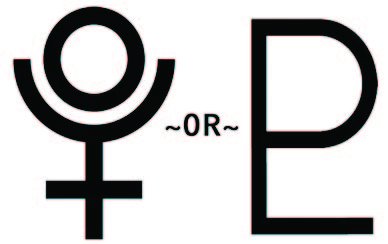Pluto
Pluto (minor-planet designation: 134340 Pluto) is a dwarf planet in the Kuiper belt, a ring of bodies beyond the orbit of Neptune. It was the first and the largest Kuiper belt object to be discovered. After Pluto was discovered in 1930, it was declared to be the ninth planet from the Sun.
Beginning in the 1990s, its status as a planet was questioned following the discovery of several objects of similar size in the Kuiper belt and the scattered disc, including the dwarf planet Eris. This led the International Astronomical Union (IAU) in 2006 to formally define the term planet—excluding Pluto and reclassifying it as a dwarf planet.
The symbol for Pluto is based on a combination of initials. The “P” represents Pluto the Roman god, and the “L” signifies Lowell, for the Lowell Observatory where it was first to discovered.
Characteristics
Pluto is the ninth-largest and tenth-most-massive known object directly orbiting the Sun. It is the largest known trans-Neptunian object by volume but is less massive than Eris. Like other Kuiper belt objects, Pluto is primarily made of ice and rock and is relatively small—one-sixth the mass of the Moon and one-third its volume. It has a moderately eccentric and inclined orbit during which it ranges from 30 to 49 astronomical units (AU) (4.4–7.4 billion km) from the Sun. This means that Pluto periodically comes closer to the Sun than Neptune, but a stable orbital resonance with Neptune prevents them from colliding. Light from the Sun takes 5.5 hours to reach Pluto at its average distance (39.5 AU).
Pluto has five known moons: Charon (the largest, with a diameter just over half that of Pluto), Styx, Nix, Kerberos, and Hydra. Pluto and Charon are sometimes considered a binary system because the barycenter of their orbits does not lie within either body.
Orbit
Pluto's orbital period is about 248 years. Its orbital characteristics are substantially different from those of the planets, which follow nearly circular orbits around the Sun close to a flat reference plane called the ecliptic. In contrast, Pluto's orbit is moderately inclined relative to the ecliptic (over 17°) and moderately eccentric (elliptical). This eccentricity means a small region of Pluto's orbit lies closer to the Sun than Neptune's.
The Pluto–Charon barycenter came to perihelion on September 5, 1989 and was last closer to the Sun than Neptune between February 7, 1979, and February 11, 1999.
Despite Pluto's orbit appearing to cross that of Neptune when viewed from north or south of the Solar System, the two objects' orbits do not intersect. When Pluto is closest to the Sun, and close to Neptune's orbit as viewed from such a position, it is also the farthest north of Neptune's path. Pluto's orbit passes about 8 AU north of that of Neptune, preventing a collision.
Human exploration
The New Horizons spacecraft performed a flyby of Pluto on July 14, 2015, becoming the first and, to date, only spacecraft to do so. During its brief flyby, New Horizons made detailed measurements and observations of Pluto and its moons. In September 2016, astronomers announced that the reddish-brown cap of the north pole of Charon is composed of tholins, organic macromolecules that may be ingredients for the emergence of life, and produced from methane, nitrogen and other gases released from the atmosphere of Pluto and transferred 19,000 km (12,000 mi) to the orbiting moon.
Mythology
From a mythological standpoint, Pluto was one of the sons of Saturn, who devoured him at birth. This suggests the deeply inward and withdrawn mentality of Pluto. An indeterminate amount of time swilling around a gut is bound to make one withdraw into the inner sanctum of the psyche. And so, there’s a clue as to the depth (and sometimes emotionally disturbing) capacity of Pluto.
After stewing in Saturn’s stomach, Pluto (and all his other siblings upon whom Saturn feasted) were rescued by Jupiter who then distributed universal responsibilities amongst the gastric captives. He made Pluto/ Hades in charge of the underworld.
Pluto manages a domain completely hidden from our common reality and physical sight; yet, there is tremendous activity in this underworld.
